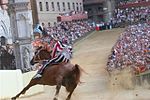Torre del Mangia
1348 establishments in Europe14th-century establishments in ItalyBuildings and structures completed in 1348Buildings and structures in SienaClocks in Italy ... and 3 more
Tourist attractions in TuscanyTowers completed in the 14th centuryTowers in Italy

The Torre del Mangia is a tower in Siena, in the Tuscany region of Italy. Built in 1338-1348, it is located in the Piazza del Campo, Siena's main square, next to the Palazzo Pubblico (Town Hall). When built it was one of the tallest secular towers in medieval Italy. At 102 m it is now Italy's second tallest after Cremona Cathedral's Torrazzo (112 m (367 ft)), the Asinelli tower in Bologna at 97 m being third.
Excerpt from the Wikipedia article Torre del Mangia (License: CC BY-SA 3.0, Authors, Images).Torre del Mangia
Vicolo della Manna, Siena Ravacciano
Geographical coordinates (GPS) Address Nearby Places Show on map
Geographical coordinates (GPS)
| Latitude | Longitude |
|---|---|
| N 43.318211111111 ° | E 11.332252777778 ° |
Address
Palazzo Pubblico (Palazzo Comunale)
Vicolo della Manna
47065 Siena, Ravacciano
Tuscany, Italy
Open on Google Maps









